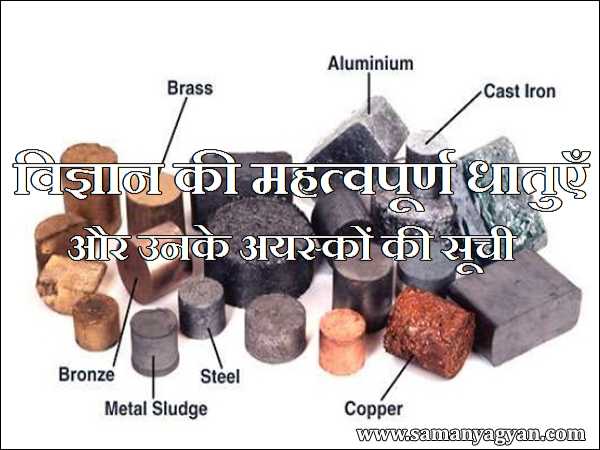Who is Ore?
Ores Those rocks are called ores which contain those minerals in which there are important elements like metals etc. ores are mined and brought out; Then the important elements are obtained by purifying them. which are called metals. Here is a list of the major metals of science and their ores.
Generally questions related to this list are asked in competitive exams. If you are preparing for various competitive exams like: IAS, Teacher, UPSC, PCS, SSC, Bank, MBA and other government jobs, then you must know about the major metals of science and their ores.
List of different metals and their ores:
| Names of important metals | Name of related ore |
| Antimony | Stibnite |
| Aluminum (Al) | Gibbsite, Boehmite, Diaspore |
| Calcium (Ca) | Calcite, Dolomite, Gypsum and Anhydrite |
| Silver (Ag) | Argentite, Silver sulfide, Azurite, |
| Zinc (Zn) | Sphalerite, Zincite, Franklinite, Calamine, Smithstone |
| Gypsum (CaSO4 2H2O) | Fluorite, Phosphorite |
| Tin (Sn) | Cassiterite, Tinstone |
| Mercury (Hg) | Cinnabar |
| Potassium (K) | Sylvinite, Hartsalz, Langbeinite, Kainite, Carnallite |
| Manganese (Mn) | Pyra, Lucite, Magnite |
| Magnesium (Mg) | Magnesite, Apsosite, Dolomite, Carnallite |
| Lead (Pb) | Galena, Anglesite |
| Iron (Fe) | Magnetite, Hematite, Siderite, Limonite |
| Sodium (Na) | Sodium chloride, Borax, Sodium nitrate, Sodium carbonate, Sodium sulfate |
| Gold (Au) | Calaverite, Sylvanite, Petzite |
| Copper (Cu) | Copper Glance, Copper Pyrite, Malachite |
| Phosphorous (P) | Phosphorite |
Important facts related to metals and minerals:
- Iron is the most abundant metal on Earth - and it also makes up most of the Earth's surface. However, the most common metal found in the Earth's crust is aluminum.
- Silver conducts electricity better than any other metal.
- Precious metals – such as the precious metals silver, gold and platinum – resist oxidation and corrosion in moist air.
- Alloys consist of two or more elements mixed together, usually two metals or one metal and one nonmetal.
- Mercury has the lowest melting point of all metals – and is the only metal that is liquid at normal room temperature and pressure.
- At 3,400 °C, tungsten has the highest melting point of any metal in its pure form.
- Although carbon remains a solid at high temperatures, it turns into a gas instead of melting into a liquid.
- Iron is galvanized by dipping it into molten zinc. The galvanization process helps prevent corrosion.
- By the Middle Ages, there were only seven known metals: bronze, iron, gold, copper, silver, lead, and mercury.
- About 69% of all steel – more than 80 million tons – is recycled in North America each year. It is much more than aluminum, paper, plastic and glass combined.
- Steel was first used for skyscrapers in 1883.
- The Eiffel Tower is about six inches taller in summer than in winter. Why? Because steel and iron expand on heating.
- Have you ever noticed how often brass doors and railings are used in public buildings? This is because brass, a copper alloy, is naturally antibacterial. (But you should still wash your hands!)
- If two pieces of uncoated metal touch in space, they stick together permanently.
- This doesn't happen on Earth because the atmosphere puts a thin layer of oxidation between the surfaces. The oxidized layer actually acts as a barrier.
Now practice related questions and see what you learnt?
☞ Metals and Ores GK Questions and Answers 🔗
Read also:
FAQs:
The main reason for making metals good conductors is their electronic structure and electrical properties. Metals are elementally structured, which means that they have one or more electrons in the shell of their molecules. These electrons provide the ability to conduct electrical charges.
Stainless steel is an alloy consisting of a mixture of various metals, mainly iron, carbon, nickel, chrome, and manganese. In addition, other elements such as molybdenum, tungsten, silica, and carmine may also contribute.
Bauxite is a mineral and it is not only a metal but it can also be an ore of aluminum besides iron. Bauxite is mainly found in the form of ore of aluminum and it is the main source of aluminum.
Brass is an alloy made from a combination of copper and zinc. By adding zinc to copper, the strength, ductility and hardness of copper increases. This increase is regular up to 36% zinc, but only after that the increase in strength is more pronounced.
Solder is usually a mixture of tin and lead. The most common type of solder used in electronics, known as "lead-tin solder" or "soft solder", contains varying proportions of tin and lead.

